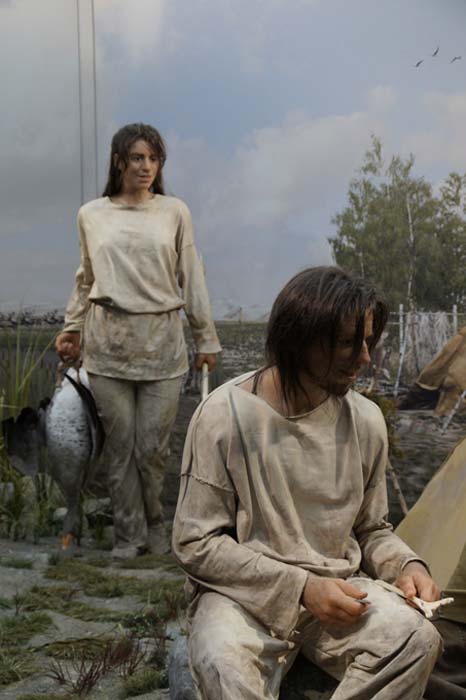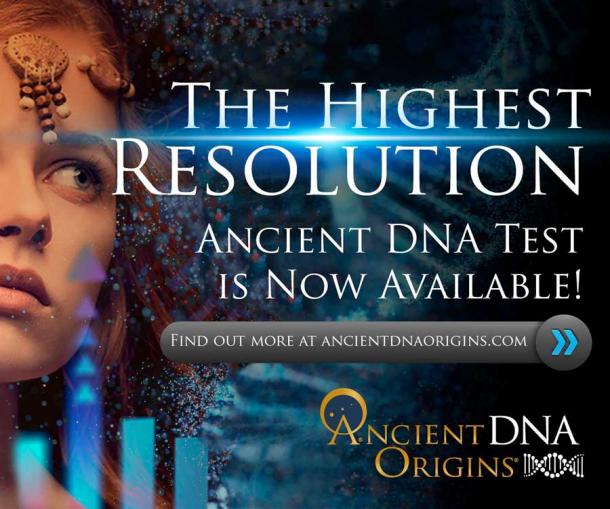
Unique Iberian Male DNA was Practically Wiped Out by Immigrant Farmers 4500 Years Ago
An international team of researchers have analyzed ancient DNA from almost 300 individuals from the Iberian Peninsula, spanning more than 12,000 years, in two studies published today in Current Biology and Science. The first study looked at hunter-gatherers and early farmers living in Iberia between 13,000 and 6000 years ago. The second looked at individuals from the region during all time periods over the last 8000 years. Together, the two papers greatly increase our knowledge about the population history of this unique region.
The Iberian Peninsula has long been thought of as an outlier in the population history of Europe, due to its unique climate and position on the far western edge of the continent. During the last Ice Age, Iberia remained relatively warm, allowing plants and animals -- and possibly people -- who were forced to retreat from much of the rest of Europe to continue living there. Similarly, over the last 8000 years, Iberia's geographic location, rugged terrain, position on the Mediterranean coast and proximity to North Africa made it unique in comparison to other parts of Europe in its interactions with other regions. Two new studies, published concurrently in Current Biology and Science, analyze a total of almost 300 individuals who lived from about 13,000 to 400 years ago to give unprecedented clarity on the unique population history of the Iberian Peninsula.

A man and woman buried side by side at the Bronze Age site of Castillejo de Bonete in Spain had different genetic ancestries. (Luis Benítez de Lugo Enrich and José Luis Fuentes Sánchez/Oppida)
Iberian Hunter-Gatherers Show Two Ancient Paleolithic Lineages
For the paper in Current Biology, led by researchers at the Max Planck Institute for the Science of Human History, researchers analyzed 11 hunter-gatherers and Neolithic individuals from Iberia. The oldest newly analyzed individuals are approximately 12,000 years old and were recovered from Balma Guilanyà in Spain.
- 4,700-Year-Old Tooth Provides Insight on the First Farmers of the Iberian Peninsula
- New study reveals Neolithic farmers assimilated local hunter-gatherers
- Tiller the Hun? Farmers in Roman Empire Converted to Hun Lifestyle

Excavation work in progress at the site of Balma Guilanyà. (CEPAP-UAB)
Earlier evidence had shown that, after the end of the last Ice Age, western and central Europe were dominated by hunter-gatherers with ancestry associated with an approximately 14,000-year-old individual from Villabruna, Italy. Italy is thought to have been a potential refuge for humans during the last Ice Age, like Iberia. The Villabruna-related ancestry largely replaced earlier ancestry in western and central Europe related to 19,000-15,000-year-old individuals associated with what is known as the Magdalenian cultural complex.
Interestingly, the findings of the current study show that both lineages were present in Iberian individuals dating back as far as 19,000 years ago. "We can confirm the survival of an additional Paleolithic lineage that dates back to the Late Ice Age in Iberia," says Wolfgang Haak of the Max Planck Institute for the Science of Human History, senior author of the study. "This confirms the role of the Iberian Peninsula as a refuge during the Last Glacial Maximum, not only for fauna and flora but also for human populations."

Prehistoric hunter-gatherers. (CC0)
This suggests that, far from being replaced by Villabruna-related individuals after the last Ice Age, hunter-gatherers in Iberia in fact already had ancestry from Magdalenian- and Villabruna-related sources. The discovery suggests an early connection between two potential refugia, resulting in a genetic ancestry that survived in later Iberian hunter-gatherers.
"The hunter-gatherers from the Iberian Peninsula carry a mix of two older types of genetic ancestry: one that dates back to the Last Glacial Maximum and was once maximized in individuals attributed to Magdalenian culture and another one that is found everywhere in western and central Europe and had replaced the Magdalenian lineage during the Early Holocene everywhere except the Iberian Peninsula," explains Vanessa Villalba-Mouco of the Max Planck Institute for the Science of Human History, first author of the study.
The researchers hope that ongoing efforts to decipher the genetic structure of late hunter-gatherer groups across Europe will help to even better understand Europe's past and, in particular, the assimilation of a Neolithic way of life brought about by expanding farmers from the Near East during the Holocene.
Ancient DNA from individuals spanning the last 8000 years helps clarify the history and prehistory of the Iberian Peninsula
The paper published in Science focuses on slightly later time periods, and traces the population history of Iberia over the last 8000 years by analyzing ancient DNA from a huge number of individuals. The study, led by Harvard Medical School and the Broad Institute and including Haak and Villalba-Mouco, analyzed 271 ancient Iberians from the Mesolithic, Neolithic, Copper Age, Bronze Age, Iron Age and historical periods. The large number of individuals allowed the team to make more detailed inferences about each time period than previously possible.

These two skeletons at La Braña in northwest Spain belonged to brothers with dark hair and blue eyes who lived 8000 years ago and were most closely related to hunter-gatherers in Central Europe. (Julio Manuel Vida Encinas)
The researchers found that during the transition to a sedentary farming life-style, hunter-gatherers in Iberia contributed subtly to the genetic make-up of newly arriving farmers from the Near East. "We can see that there must have been local mixture as the Iberian farmers also carry this dual signature of hunter-gatherer ancestry unique to Iberia," explains Villalba-Mouco.
- Should We Thank or Blame the Ancestors? Ancient Farmers Stop the Ice Age
- Farmers and Hunter-Gatherers coexisted but did not mix for two millenia
- New Study Indicates that Europe Owes Ancestry and Agriculture to Early Anatolian Farmers
Between about 2500-2000 BC, the researchers observed the replacement of 40% of Iberia's ancestry and nearly 100% of its Y-chromosomes by people with ancestry from the Pontic Steppe, a region in what is today Ukraine and Russia. Interestingly, the findings show that in the Iron Age, "Steppe ancestry" had spread not only into Indo-European-speaking regions of Iberia but also into non-Indo-European-speaking ones, such as the region inhabited by the Basque. The researchers' analysis suggests that present-day Basques most closely resemble a typical Iberian Iron Age population, including the influx of "Steppe ancestry," but that they were not affected by subsequent genetic contributions that affected the rest of Iberia. This suggests that Basque speakers were equally affected genetically as other groups by the arrival of Steppe populations, but retained their language in any case. It was only after that time that they became relatively isolated genetically from the rest of the Iberian Peninsula.

Olentzero in Beasain. Gipuzkoa, Basque Country. (Izurutuza/CC BY SA 3.0)
Additionally, the researchers looked at historical periods, including times when Greek and later Roman settlements existed in Iberia. The researchers found that beginning at least in the Roman period, the ancestry of the peninsula was transformed by gene flow from North Africa and the eastern Mediterranean. They found that Greek and Roman settlements tended to be quite multiethnic, with individuals from the central and eastern Mediterranean and North Africa as well as locals, and that these interactions had lasting demographic as well as cultural impacts.
"Beyond the specific insights about Iberia, this study serves as a model for how a high-resolution ancient DNA transect continuing into historical periods can be used to provide a detailed description of the formation of present-day populations," explains Haak. "We hope that future use of similar strategies will provide equally valuable insights in other regions of the world."
Top Image: Farmers from the Pontic Steppe drastically transformed Iberian DNA 4500 years ago. Source: Out of the Woods
The article, originally titled ‘Unique diversity of the genetic history of the Iberian Peninsula revealed by dual studies’ was first published on Science Daily.
Source: Max Planck Institute for the Science of Human History. "Unique diversity of the genetic history of the Iberian Peninsula revealed by dual studies." ScienceDaily. ScienceDaily, 14 March 2019. www.sciencedaily.com/releases/2019/03/190314151551.htm
References
Pau Castel, Alice Cheng, Antonio Cuevas-Navarro, David B. Everman, Alex G. Papageorge, Dhirendra K. Simanshu, Alexandra Tankka, Jacqueline Galeas, Anatoly Urisman, Frank McCormick. RIT1 oncoproteins escape LZTR1-mediated proteolysis. Science, 2019; 363 (6432): 1226 DOI: 10.1126/science.aav1444
Vanessa Villalba-Mouco, Marieke S. van de Loosdrecht, Cosimo Posth, Rafael Mora, Jorge Martínez-Moreno, Manuel Rojo-Guerra, Domingo C. Salazar-García, José I. Royo-Guillén, Michael Kunst, Hélène Rougier, Isabelle Crevecoeur, Héctor Arcusa-Magallón, Cristina Tejedor-Rodríguez, Iñigo García-Martínez de Lagrán, Rafael Garrido-Pena, Kurt W. Alt, Choongwon Jeong, Stephan Schiffels, Pilar Utrilla, Johannes Krause, Wolfgang Haak. Survival of Late Pleistocene Hunter-Gatherer Ancestry in the Iberian Peninsula. Current Biology, 2019; DOI: 10.1016/j.cub.2019.02.006

















Comments
The headline has a mistake. The Neolithic Iberian males who were replaced were the farmers. The Pontic Steppe immigrant invaders were herders.
Yamnaya (pontic sttepe, Ukraine) and Corded Ware (northwestern Europe and Russia) were two different people. Yamnaya had haplogroup R1b and Corded Ware had haplogroup R1a.
The Iron Age Britons were from the same stock (Bell Beaker/Corded Ware) as the Iberian invaders.
The difference in the British Isles being a near total replacement of the Neolithic Farmers at 90%, rather than just replacement of the males as happened in Iberia.
Thought the English had a quite mixed up genetic background, feel more normal now.
WELL, Iberian males EFFECTIVELY wiped out the Indian DNA in the Caribbean and Central/South America
Pages